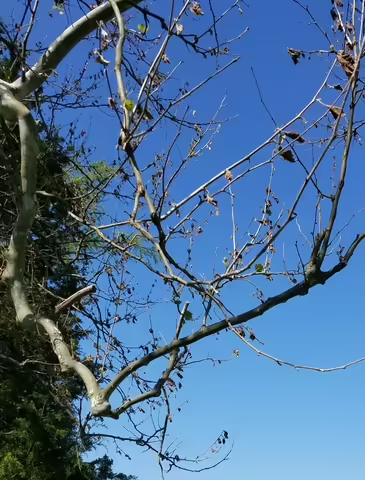A drive through any town or park in central Illinois and you will notice that most sycamore trees are void of any green leaves. So, what is causing this problem?
Anthracnose, which is a disease that thrives with cool spring temperatures and frequent rains, is most likely the
cause. The spores spread by wind and water to new growth. The extent of the disease depends on weather conditions and the host plant. This has been the perfect spring for this disease. Most of the infections occur in the two weeks following bud break. Anthracnose can affect most shade trees, most often affected in Illinois are ash, dogwood, elm, maple, oak, sycamore and walnut.
Anthracnose is a common name given to a group of related fungal leaf and stem diseases. Different fungi produce anthracnose on specific host plants. The fungi causes tan to brown to black lesions on the leaves, stems, flowers and fruits of various plants. The color of the lesions and symptoms of anthracnose vary depending on the tree species. Infected leaves range from tiny dead spots to large circular or irregular dead blotches. On sycamore and maple, infected areas often develop along the leaf veins and midribs, and expand outward to the leaf edge. This causes the leaf to become distorted. Heavily infected leaves often curl and drop prematurely, littering the ground.
In the early spring, newly emerged leaf tissue of sycamores infected with cankers will suddenly wilt and turn brown. The fungus grows from leaf tissue down the leaf petiole and into stem tissue. (Do not confuse the natural fuzziness of a sycamore leaf with this infection.) The fungus spores will overwinter within the cankers. In the spring the spores can reinfect the tree and spread the disease to other trees. Cankers in branches can girdle and kill the branch. Twig blight refers to the death of 1 year old twigs. Repeated annual bud or twig dieback stimulates the development of many short twigs at the base of the dead twigs given the tree a “witches broom” appearance.
While this is a common and unsightly shade tree disease, anthracnose is rarely fatal to a tree. However, repeated infections can weaken trees. Healthy, vigorous growing trees should quickly recover. An exception is dogwood anthracnose. This is an aggressive disease that can cause permanent damage and death of dogwoods.
So what can be done for infected trees?
The first step is to properly identify the problem. A fact sheet on “Anthracnose diseases of shade trees can be found on the University of Illinois Extension website at http://ipm.illinois.edu/diseases/series600/rpd621/index.html .
Generally fungicides are not recommended except for dogwood anthracnose. Fungicides must be applied before damage appears and the whole tree would need treated. This is general cost prohibitive.
The fungus overwinters within fallen leaves and twigs. Therefore, sanitation is important in minimizing the severity of the disease in the following year. Rake up and discard fallen leaves and twigs. To prevent reinfection, remove or bury all diseased plant parts.
Maintain good tree health. Water trees during periods of drought. Supply 1 to 2 inches of water weekly during dry periods. Be sure to apply water slowly and deeply. Mulch the root zone of the tree with a two to four inch deep layer of an organic mulch such as wood chips.
Fertilize trees in the late fall to maintain tree vigor. Trees that have severe anthracnose infection and defoliate early may weaken. Defoliation depletes the energy reserve of the tree and increases its susceptibility to other pests and diseases. In addition yearly infections can reduce growth and may predispose the tree to other stresses.
Make sure trees have proper spacing for good air circulation. Thin out excessive twig and branch growth.
Sycamore anthracnose can also overwinter in cankers on stems within the tree canopy. If possible, prune out infected twigs and branch cancers.
If this disease causes you stress, plant tree varieties that are resistant to anthracnose.
